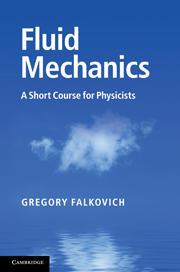1 - Basic equations and steady flows
Published online by Cambridge University Press: 05 June 2012
Summary
In this chapter, we define the subject, derive the equations of motion and describe their fundamental symmetries. We start from hydrostatics where all forces are normal. We then try to consider flows this way as well, neglecting friction. This allows us to understand some features of inertia, most importantly induced mass, but the overall result is a failure to describe a fluid flow past a body. We are then forced to introduce friction and learn how it interacts with inertia, producing real flows. We briefly consider an Aristotelean world where friction dominates. In an opposite limit, we discover that the world with a little friction is very much different from the world with no friction at all.
Definitions and basic equations
Here we define the notions of fluids and their continuous motion. These definitions are induced by empirically established facts rather than deduced from a set of axioms.
Definitions
We deal with continuous media where matter may be treated as homogeneous in structure down to the smallest portions. The term fluid embraces both liquids and gases and relates to the fact that even though any fluid may resist deformations, that resistance cannot prevent deformation from happening. This is because the resisting force vanishes with the rate of deformation. Whether one treats the matter as a fluid or a solid may depend on the time available for observation. As the prophetess Deborah sang, ‘The mountains flowed before the Lord’ (Judges 5:5).
Information
- Type
- Chapter
- Information
- Fluid MechanicsA Short Course for Physicists, pp. 1 - 53Publisher: Cambridge University PressPrint publication year: 2011
